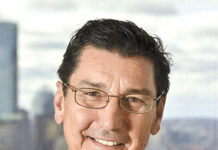By Dave Carpenter
CHICAGO —
As a historic bull market reached its second birthday, everyday investors began piling back into stocks, finally ready for more risk and hoping the rally has further to go.
The Standard & Poor’s 500 index has almost doubled since March 9, 2009, when it hit a 12-year low after the financial crisis. And the Dow Jones industrials are back above 12,000, about 2,000 points shy of their all-time high.
Little-guy investors appear to be on board. Since the beginning of the year, investors have put $24.2 billion into U.S. stock mutual funds, according to the Investment Company Institute. They withdrew $96.7 billion in 2010.
“It didn’t feel right to be back in until now,” said Richard Dukas, who heads a public relations firm in New York City. “I still don’t want to put all my money in the market, but I believe we’ve come through the worst of it.”
After the 2008 financial meltdown, Dukas and his wife converted their company-sponsored retirement accounts into cash. They had been burned during the bubble in technology stocks a decade ago, and Dukas said he has been “extremely skittish” ever since.
Now Dukas, 48, says 85 percent of his portfolio is back in mutual funds, although he maintains a small cushion of cash.
More job security, strengthening retirement investment account balances and improvement in the overall U.S. economy are some of the factors that have brought everyday investors back to the market. A snapshot of what’s happened:
•The outlook of investors as measured by stock newsletters and market surveys has been extremely bullish for two or three months, said Mark Arbeter, chief technical strategist for S&P Equity Research.
•Many workers have enjoyed seeing their retirement account balances return to where they stood at the market’s peak because they kept contributing during the down years. Many who have maintained their accounts for a decade or longer still have some ground to make up because of their larger starting balances.
•Americans who still have jobs are as secure as they’ve been in 14 years. That’s because the number of planned layoffs has fallen to a low, according to outplacement firm Challenger, Gray & Christmas.
The combination has boosted confidence and brought investors back to a rising market.
While the economy is improving, it will take a lot longer to erase the abject fear that average investors have felt about owning stocks the last two years, said Jason Trennert, chief investment strategist for Strategas Research Partners in New York.
One reason to set aside their reservations: They can’t find a better place to stash their money. The bull market in bonds has ended, money-market accounts are returning 1 percent or less, and the average two-year CD (certificate of deposit) earns no more than 1.5 percent.
As a result, many investors returning to the market are tiptoeing back in. They’re buying what Trennert calls “stocks that look like bonds” — dividend-paying blue chips that they hope will hedge their risk by guaranteeing at least a dividend payout.
For example, while stocks like Johnson & Johnson and Procter & Gamble haven’t gone up much since 2009, their yields — 3.5 percent and 3.1 percent, respectively — mean investors can still pocket something.
“What swayed me is being frustrated having my money parked where it’s earning almost nothing,” says Debra Condren, a New York business consultant, who has been easing back into the market over the last four months. She still has only 30 percent of her investments in stocks, compared with 80 to 85 percent before the crash.
Besides reinvesting gradually, Condren said she is much more vigilant about her stocks. She said she won’t hesitate to sell if she doesn’t like what she sees in the market or senses a shift based on world events.
Among professional money managers, the shift back into stocks has been more dramatic. A February survey by Bank of America-Merrill Lynch of 270 top investment managers found them more bullish about stocks than at any time in the past decade.
But history shows experts may not have better insight about what’s next. Plus, individual investors notoriously follow the crowd. So is it a worrisome sign that they’re flocking back?
“Investors have the tendency to make the wrong decisions behaviorally,” said Christopher Geczy, academic director of the Wealth Management Initiative at the University of Pennsylvania’s Wharton School.
When they pile in or out of stocks, he said, it often signals that the market is about to turn in the opposite direction. For instance, investors pumped nearly $91 billion into stock funds in 2007, just as the market was reaching its all-time peak.
Yet analysts point to signs that the run could keep going for quite a while, as long as the economy cooperates. Corporations are still sitting on billions of dollars in cash that they may ultimately put to work in the market.
The S&P 500 has an average gain of 17 percent in the third year of a presidential cycle. But the market also tends to grow much more slowly in the third year of a bull run.
Stock prices are still not high by historic standards. The S&P 500 index now trades at 15.6 times the operating earnings of its stocks over the past year, well under the historical average of 19.3.
There are plenty of investors still looking for an opportunity to get back in. Kenneth Kracmer, who owns a marketing firm in Dallas, is restless after cutting his stock allocation by half, to 30 percent.
But he worries about unemployment, state governments in financial distress and a market he sees as artificially high in view of all the challenging economic news. — AP











